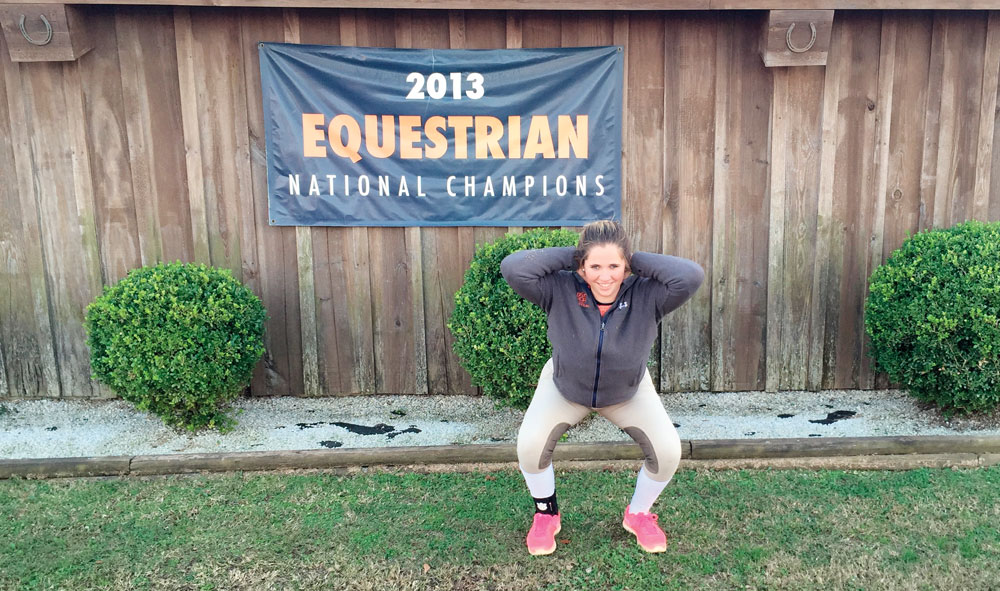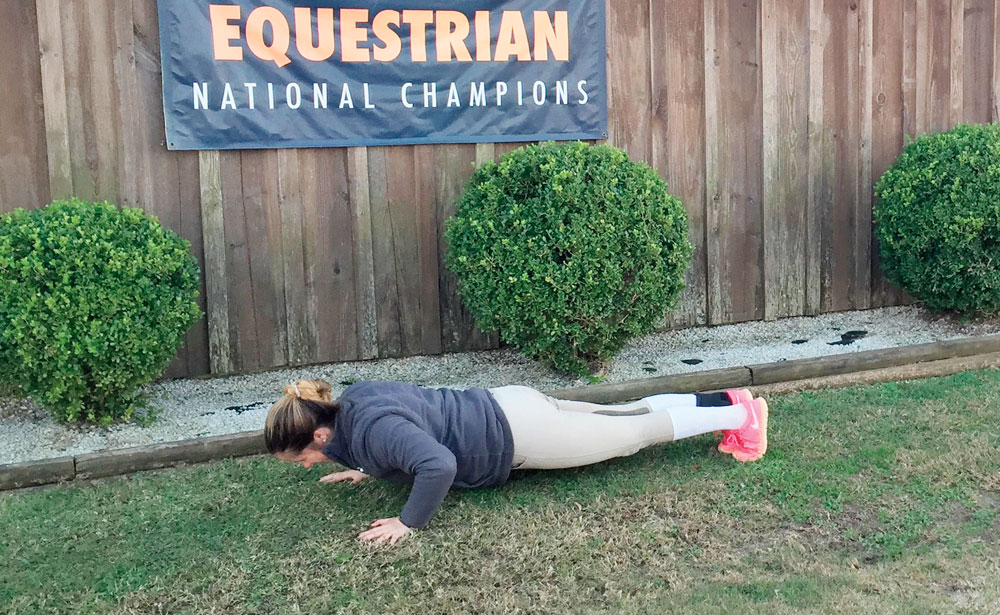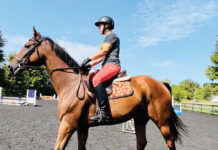Photos Courtesy Auburn Athletics Department
Step One: Schedule Workout Time
The first step is to find the time to get back into workout mode. Having two or three months off from regular exercise means many of us used that free time to catch up on Christmas cookies and Netflix. Now it’s time to reorganize your schedule and make the time to work out routinely.
You’re looking for a 30- to 60-minute window, depending on the activity. It might mean waking up a little earlier in the morning to fit in your sweat session before work or morning chores. Just remember that this extra time is important for your health and to make you a better rider.
Some things to consider when reworking your schedule:
- When are you most comfortable working out? Are you a morning person, or do you have more energy in the afternoon? I, for one, love to work out in the mornings. I feel it’s the best way to start my day, plus I already have it over with so I don’t run into excuses as to why I can’t work out today.
- Where are you going to work out? Are you thinking of joining a gym, or are you motivated enough to work out at home? Or, are you thinking you’re going to be able to do your workouts while at the barn (thus, attempting to kill two birds with one stone)? If you’re thinking about the gym, you’ll have to build in time for driving to and from, so keep that in mind.
- How many days a week do you plan to work out? Studies show that we should be physically active for at least 30 minutes every day. But we’re talking extra activity to improve fitness. Are you aiming to work out every day or every other day? (We’ll hit on this question a little later.)

Step Two: Start Slow
Before starting any workout activity, make sure you discuss your plans with your doctor. You want to be sure that you’re physically able to do the activities you want to.
Also, you’ll want to keep your history of exercise activity in mind while planning your new routine. You might have been an avid runner prior to winter, only to have backed off because of the weather. Or, perhaps you’ve never been very active and decided that 2016 is your year. Whichever end of the spectrum you’re on, consider this: An exercise neophyte might be overwhelmed by jumping in to a full routine with weights and high-intensity cardio. But if you’re already used to hitting the weights and treadmills, you’ll be bored to tears in beginner classes.
Step Three: Get to Work
Anthony Kincy is the assistant athletic performance coach at Auburn University in Auburn, Ala., where he oversees the three-time national champion equestrian team’s strength and fitness routine. He advises that riders try to stick with working out two to three days a week for three weeks to start a habit.
“If two of those days are some type of strength exercise and one day is cardio or yoga, that will get you in a better position to get ready to ride and tackle the season,” he says.
Here are the top four areas Kincy recommends working on for equestrians.
1. Lower Body
Body weight squats are an easy, go-anywhere exercise you can do at home, the gym, or the barn.
The basic squat starts with your feet just a little bit wider than shoulder-width. Bend your knees while driving your hips backward and keeping your lower legs perpendicular to the floor. Go down until your hips are even with your knees, and then stand straight up.
Other variations include holding at the bottom for four seconds, split squats (one foot in front, one in back—a lunge), and using weights (saddle held out in front of you, canned goods in each hand, et cetera).
“This is an exercise that I recommend when you’re looking for power from your legs,” says Kincy.
2. Upper Body
“The best bang for your buck with your upper body is the push-up,” says Kincy.
Kincy explains that push-ups are commonly difficult for women to perform if they lack upper body strength. To combat this, the team at Auburn works in three-week blocks with incline push-ups, slowly modifying them until they are on the ground.
“I’m not a fan of push-ups on the knees,” he explains. “Going from an incline is better than starting on your knees because you engage your core more on the incline than you would on your knees.”
You, too, can work in steps to move down to full push-ups by using any supported elevated surface, such as a wooden fence. Start at the top panel and lower your chest to the fence, then push-up. Three weeks later, move down to the next panel, et cetera.

3. Core
“Our program focuses on core stability and posture,” says Kincy. He prefers using the plank, either on your hands (directly under your shoulders) or on your forearms. Variations for the plank include side plank (twisting to one side and holding), reaching forward with one arm straight (if doing on your hands), and then holding one arm in front and lifting one leg.
Click here for a simple core exercise routine designed for riders.
4. Flexibility/Mobility
Stretching daily is a must for improving range of motion. Kincy also recommends taking a yoga class once a week, or doing a yoga DVD at home.
“Yoga is big as far as having your mind and muscles working together, which is important for a rider,” he says.
Cardio Fitness
Running and spin class are two examples of high-intensity cardio workouts. Having cardio fitness is especially important as a rider if you do a demanding equestrian sport with high speeds and/or jumping. Just try jumping even a tiny course while out of shape to see how fast you’re gasping for air!
If you’ve never been a runner, start off with brisk walking for 15 to 20 minutes a day, and then work up to run/walk intervals. Taking a spin class is another way to start building up your cardiovascular fitness, as is using any cardio equipment such as ellipticals, stationary bikes, and treadmills. Just be sure you’re putting in enough effort so you’re breathing hard and sweating by the end.
If running or spinning isn’t your thing, incorporate tempo exercises with your strength workouts. Kincy recommends adding 30 seconds of high-intensity cardio workouts between sets. These could be mountain climbers, jumping jacks, jump rope, high knees, butt kickers, burpees, or sprints.
Varying the workout will not only keep your muscles guessing—helping them increase in strength—but it will also keep you motivated to work out again. Have a workout buddy that will either work side by side with you or check in with you regularly. Stick with a routine, and you’ll be ready for riding season in no time.
Special thanks to Hayley Iannotti, a member of the Auburn University equestrian team, for demonstrating these exercises.
Click here for workouts from Coach Kincy that you can start doing today.
This article originally appeared in the March 2016 issue of Horse Illustrated magazine. Click here to subscribe!






